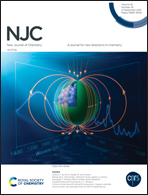Synthesis, structural characterization, protein binding, DNA cleavage and anticancer activity of fluorophore labelled copper(ii) complexes based on 1,8-naphthalimide conjugates†
Abstract
The two novel fluorophore labelled copper(II) complexes [Cu(L)2(DMF)Cl2] (1) and [Cu(phen)(L)Cl2] (2) (where L = N-(3-pyridyl)-1,8-naphthalimide, phen = 1,10-phenanthroline, DMF = dimethylformamide) were synthesized and structurally characterized by single-crystal X-ray structure determination. Complexes 1 and 2 were highly fluorescent in aqueous as well as organic solvents. The complexes efficiently cleave DNA, which was investigated by agarose gel electrophoresis. The interactions of the complexes with BSA (bovine serum albumin) were investigated by fluorescence spectroscopy. The anticancer activity of 1 and 2 in comparison with cisplatin was studied by MTT (3-[4,5-dimethylthiazol-2-yl]-2,5-diphenyltetrazolium bromide) assay towards MDA-MB-231 (epithelial human breast cancer cell line) and A549 (adenocarcinomic human alveolar basal epithelial cell line) cell lines. Both the copper complexes have better anticancer activity than cisplatin towards the MDA-MB-231 and A549 cell lines. Complex 2 has nine times higher anticancer activity than cisplatin towards the A549 cell line. The mode of cell death induced by the complexes was investigated by DAPI staining and flow cytometry. The cellular uptake of the complexes was investigated by fluorescence microscopy. The complexes induce an apoptotic mode of cell death.



 Please wait while we load your content...
Please wait while we load your content...